By Sue Swiggum, Trond Austheim & Børge Solem. (Revised 2024 by Børge Solem)
US arrivals - Customs Passenger Lists
Records of the U.S. Customs Service (1820 - ca. 1891), Records of the Immigration and Naturalization Service, (1891 - 1957)
The transatlantic crossing was dangerous and many passengers did not survive because of the rough conditions aboard many ships. But, there was a limit to how many passengers a ship could carry, and how the ships should be fitted and equipped to carry passengers. The majority of the emigrants traveled as steerage passengers, and were more or less considered as cargo. No Ship was to sail for North America with more than 3 persons on board for every 4 tons of burthen. This was regulated by the US passenger act of 1819:
- SEC.4; And be it further enacted, That the captain or master of any ship or vessel arriving in the United States, or any of the territories thereof, from any foreign place whatever, at the same time that he delivers a manifest of the cargo, and, if there be no cargo, then at the time of making report or entry of the ship or vessel, pursuant to the existing laws of the United States, shall also deliver and report, to the collector of the district in which such ship or vessel shall arrive, a list or manifest of all the passengers taken on board of the said ship or vessel at any foreign port or place; in which list or manifest it shall be the duty of the said master to designate, particularly, the age, sex, and occupation, of the said passengers, respectively, the country to which they severally belong, and that of which it is their intention to become inhabitants; and shall further set forth whether any, and what number, have died on the voyage; which report and manifest shall be sworn to be the said master, in the same manner as is directed by the existing laws of the United States, in relation to the manifest of the cargo, and that the refusal or neglect of the master aforesaid, to comply with the provisions of this section, shall incur the same penalties, disabilities, and forfeitures, as are at present provided for a refusal or neglect to report and deliver a manifest of the cargo aforesaid.
Beginning January 1st 1820, the U.S. Government required such passenger lists to be filed by the ship master with the collector of Customs in the port of entry to make sure the law was not violated. Many of these lists have survived and are available at the National Archives and Records Administration (NARA):
The US National Archives (NARA), Introduction and Links to Resources
p>By studying a number of these lists you will find that they are actually not compiled by the ship's master, but rather by a clerk with the collector of customs. You will se the same handwriting on many lists of different ships. In some cases parts of the lists seams to be compiled by the captain, while other parts are compiled by the customs as a formality. The content varies a lot from list to list.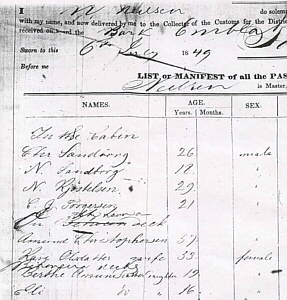
Heading and top of the passenger list for the Norwegian bark Embla which arrived at New York in 1849. This list is quite typical for this period. Note that in the column "OCCUPATION", all of the passengers are listed as "farmers". The word "farmers" is just written once at the top of the list. The same goes for the column with the heading "The country to which they severally belong", where "Norway" is just repeated for all of the passengers, and the column "The Country in which they intend to become inhabitants". In many cases we know that this information is wrong, as we have identified craftsmen and Swedes on several lists, listed as "farmers" and "Norway". Also typically for the "OCCUPATION" column is "Farmers and Mechanics". The reason for not being more accurate is probably that these information was not of a great importance, according to the purpose of the list, which was actually to count the number of passengers to see if the captain was going to be charged any fees for carrying to many according to the regulations. The column "Died on the voyage" seams not to have been filed on many of these lists, even though we know there had been deaths aboard, the column is often empty. The list below is from the Ebenezer in 1850, it is slightly more detailed than the above
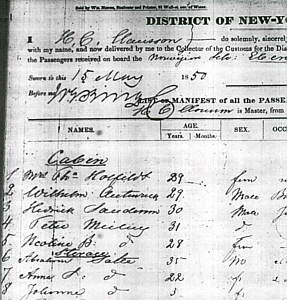
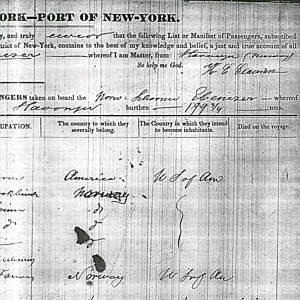
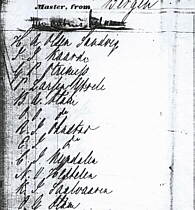
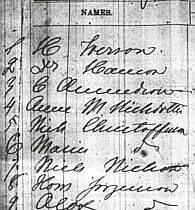
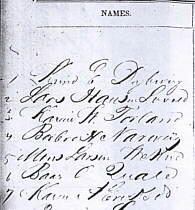
This is an example of how different the lists can be. The one to the left gives only the initials to the first and middle name, and only the patronymic as a surname. The middle scan shows a list which have full first names but only the patronymic as surname. The scan to the right shows a better list, giving us the full names, first name, patronymic, and the farm name as surname.
You should keep in mind when working on these old lists, that they may contain a lot of errors. Ages and nationality might be wrong among other things. Below is a scan of a passenger list for the S/S British Prince of the American Line, arriving to Philadelphia on 27th April 1882 (her maiden voyage). I was submitted by Harald Bakke and clearly shows Norwegian passengers listed as Germans, on the same list there were also Norwegians listed as Irish.
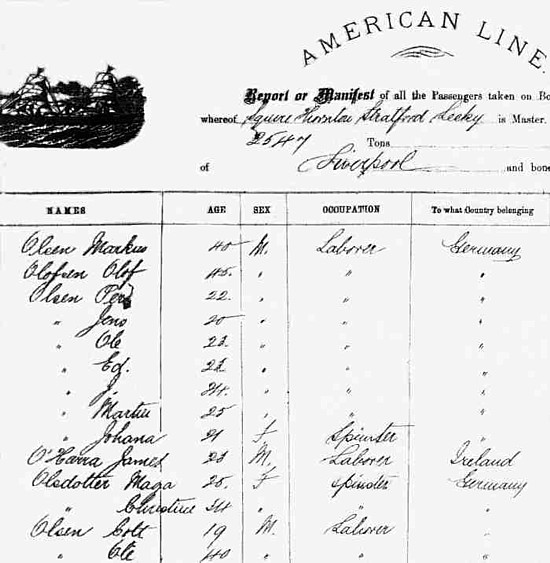
The lists remained more or less in this way until the creation of the Department of Immigration in 1891. From then a more standardized form was put into use.
The passenger lists are all available on microfilm. Microfilms can be ordered from NARA, for a quite reasonable price. They should also be available by Inter Library Loan, or from the LDS family centers. We have started transcribing the pre 1876 Norwegian New York (and Quebec) arrivals, you can serach our database by going to the emigrant search page. For Norwegian passenger lists one should also be aware Gerhard B. Naeseth's work; "Norwegian Immigrants To The United States, a biographical directory, 1825 - 1850". There are several volumes, issued by The Vesterheim Museum.
The New York Passenger Arrivals are Soundexed for the years 1902-1943. You will need to Soundex your surname with the Code (found at LDS FHC Library) then order the microfilm for that code at the LDS FHC Library. If your ancestor's surname is in the Soundex, it will tell you the date and ship your ancestor arrived on. You can then either order the microfilm for this date at the LDS FHC Library, or order it directly from the National Archives in Washington DC.
The Family Search Internet Genealogy Service from The Church of Jesus Christ of Latter-day Saints have an extensiv genealogy database. LDS web site
There is no index for 1847-1896....for Ellis Island
New York
Indexes to passenger lists
- 1820-1846.................................... M261 alphabetical
- 1897-1902.................................... T519 ditto
- 1902-1943.................................... T621 soundex
- 1906-1942.................................... T612 alphabetical
- 1944-1948.................................... M1417soundex
Passenger lists
- 1820-1897.................................... M237 arr. by date
- 1897-1957 (includes crew lists).............. T715 arr. by date
- Registers of vessels, 1789-1919.............. M1066 ditto
On April 17th, 2001 the Ellis Island American Family Immigration History Center's online database of passenger lists was opened. It contained the records of 17 million Ellis Island immigrants who immigrated through the port of New York during the period 1892-1924. This is now found at the The Statue of Liberty—Ellis Island Foundation
However, not all passenger entering through New York proceeded through Ellis Island. Read more in Jo Anne Sadler's article: PORT OF NEW YORK PASSENGER RECORDS
Immigration Processing Centers for New York:
Aug 1, 1855 - April 18, 1890 Castle Gardens
April 19, 1890 - Dec 31, 1891 Barge Office
Jan 1, 1892 - June 13, 1897 Ellis Island
June 14, 1897 - Dec 16, 1900 Barge Office
Dec 17, 1900 - Dec 31, 1924 Ellis Island
An other useful source for passenger lists is the IMMIGRANT SHIPS TRANSCRIBERS GUILD. Volunteers have transcribed passenger lists from a various of different ports. If you are lucky you could find your Norwegian ancestor on one of them.
The Castlegarden.org database contained records of immigrants who arrived at Castle Garden between 1830 and 1890. The Scandinavian names in the database contained a significant number of errors, making it difficult to locate individuals through searches. The old Castle Garden website is no longer operational, but the records are now hosted and made available on FamilySearch.
